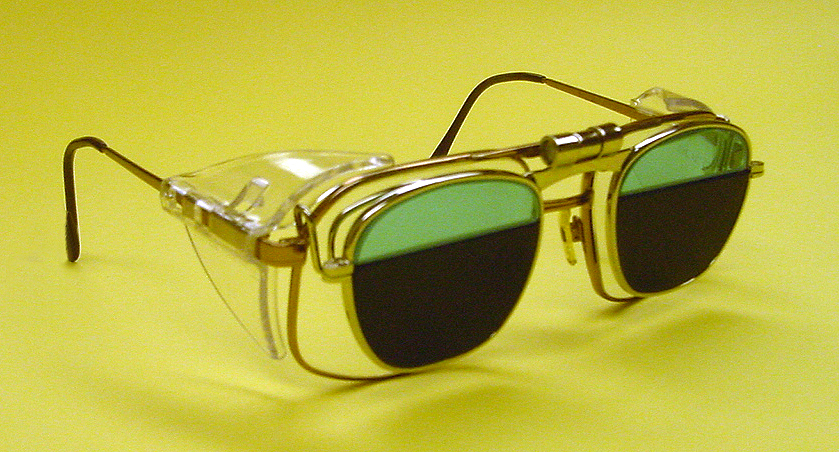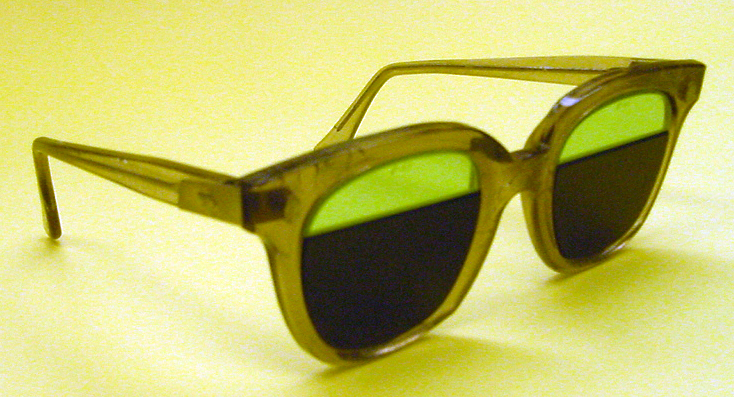Glassblowing Glasses
 Glassblowing glasses or goggles are necessary when you are
performing glassblowing operations involving heating glass sufficiently to allow working it.
They are also necessary if you are near enough to such an operation to see the light from the heated glass.
These operations produce
Glassblowing glasses or goggles are necessary when you are
performing glassblowing operations involving heating glass sufficiently to allow working it.
They are also necessary if you are near enough to such an operation to see the light from the heated glass.
These operations produce

 radiation of wavelengths and intensities that can seriously damage
the eyes as well as visible light bright enough to make it difficult to see the work being done.
radiation of wavelengths and intensities that can seriously damage
the eyes as well as visible light bright enough to make it difficult to see the work being done.
 There
are 2 types of glass typically used for scientific purposes.
The most common is borosilicate glass (Pyrex).
This type of glass requires the use of dydimium lens safety glasses, which filter out the intense
yellow light emitted by heated glass.
The other common type of glass is quartz.
This type of glass must be heated to a much higher temperature (1600 oC) and produces significantly
more harmful radiation (both infrared and ultraviolet).
There are a number of styles of glassblowing glasses available, all with a choice of filter shades.
They are available as various styles of glasses, versions that fit over conventional glasses, and a
clip on version that can be attached to regular glasses.
There are some that are available with a split lens that has the top 1/3 dydimium glass and the bottom 2/3
a shade for quartz.
A welding shade of 6 or 8 is generally used for quartz glassblowing.
The darker shade is generally used for larger workpieces.
The hazard
assessment for your glassblowing operation should prescribe the
proper glasses that will be necessary for your overall eye protection from the types of glass being
worked. There
are 2 types of glass typically used for scientific purposes.
The most common is borosilicate glass (Pyrex).
This type of glass requires the use of dydimium lens safety glasses, which filter out the intense
yellow light emitted by heated glass.
The other common type of glass is quartz.
This type of glass must be heated to a much higher temperature (1600 oC) and produces significantly
more harmful radiation (both infrared and ultraviolet).
There are a number of styles of glassblowing glasses available, all with a choice of filter shades.
They are available as various styles of glasses, versions that fit over conventional glasses, and a
clip on version that can be attached to regular glasses.
There are some that are available with a split lens that has the top 1/3 dydimium glass and the bottom 2/3
a shade for quartz.
A welding shade of 6 or 8 is generally used for quartz glassblowing.
The darker shade is generally used for larger workpieces.
The hazard
assessment for your glassblowing operation should prescribe the
proper glasses that will be necessary for your overall eye protection from the types of glass being
worked.
 Glasses have been donned properly when they are comfortably situated on head and face
in a position that prevents the possibility of exposure of the eyes to the radiant energy
emitted by the process. Visually inspect the PPE for damage (cracks, scratches, torn
or worn elastic band) before use and after removal. Do not use eyewear with defects
or weaknesses.
Glasses have been donned properly when they are comfortably situated on head and face
in a position that prevents the possibility of exposure of the eyes to the radiant energy
emitted by the process. Visually inspect the PPE for damage (cracks, scratches, torn
or worn elastic band) before use and after removal. Do not use eyewear with defects
or weaknesses.
 Filter lenses will only protect your eyes if you use the proper minimum shade and
if you only view the radiant energy source through the filter.
Keep your eyes covered.
If you use split lenses, be sure to look through the correct filter for the glass you are working.
Filter lenses will only protect your eyes if you use the proper minimum shade and
if you only view the radiant energy source through the filter.
Keep your eyes covered.
If you use split lenses, be sure to look through the correct filter for the glass you are working.
 Clean with mild soap and water. Store in
a protected, dry, temperate location to protect from damage. Hanging goggles from
their elastic band will cause unnecessary wear on the band, causing it to loose its
elasticity and fail.
Avoid laying glasses or goggles down in a manner that could scratch the lenses.
Old glassblowing glasses can be disposed of as regular trash.
Clean with mild soap and water. Store in
a protected, dry, temperate location to protect from damage. Hanging goggles from
their elastic band will cause unnecessary wear on the band, causing it to loose its
elasticity and fail.
Avoid laying glasses or goggles down in a manner that could scratch the lenses.
Old glassblowing glasses can be disposed of as regular trash.
|





